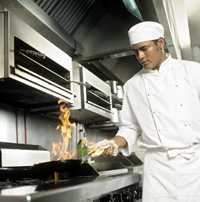Food Safety Practices of Restaurant Workers
This page shows the study purpose, method, results, conclusions, and recommendations in plain language for the EHS-Net project titled Food Workers’ Food Preparation Practices Population Study.
The findings and recommendations from this project are also in fact sheet format [PDF - 450 KB].
Citations for more EHS-Net publications are available by Study Topic or by Citation.

Study Problem
Studies show that foodborne illness is linked to eating outside the home (for example, in restaurants). They also show that food workers often do not handle food safely. It is important to learn more about how restaurant workers prepare food. This can help us find ways to improve how they prepare food.
Study Purpose
This study looked at four things restaurant workers do that affect food safety:
- Wash their hands when they should.
- Use gloves properly.
- Use a thermometer to check the temperature of cooked food.
- Not work when they have vomiting or diarrhea.
Vomiting and diarrhea are symptoms of illnesses that can be passed through food.
Study Findings in Brief
EHS-Net found that:
- Many food workers said they engaged in risky food preparation (food prep) practices.
- Younger, less-experienced workers more often reported risky food prep practices.
- Workers in independent restaurants (compared to chain restaurants) more often reported risky food prep practices.
Study Method
Participants
We collected data from 486 restaurant workers in nine states.
Data Collection
We called workers and asked them about five food-safety practices.
Study Results
Food safety Practices
In an 8-hour shift, workers
- Washed their hands an average of 15.7 times.
- Changed their gloves an average of 15.6 times.
More than half of workers did not always wear gloves while touching ready-to-eat food.
Between touching raw meat and poultry and touching ready-to-eat food,
- About one of every four workers did not always wash their hands.
- One of every three workers did not always change their gloves.
Just over half of those who cooked food did not usually use a thermometer to check if food was done.
Some workers (5%) said they had worked while they had vomiting or diarrhea in the past year.
Differences in Food-safety Practices
Workers who were 25 and older
- Washed their hands more often than those under 25.
- Changed their gloves more often than those under 25.
Managers washed their hands more often than did nonmanagers.
Workers who cooked changed their gloves more often than those who did not cook.
Workers in chain restaurants used a thermometer to see if food was done more often than other workers did.
Study Conclusions
Food workers reported risky food prep practices. These practices include
- Not washing hands or changing gloves between touching raw meat or poultry and ready-to-eat food. This increases risk for cross contamination of those foods.
- Not using a thermometer to check the temperature of cooked foods. This increases the risk that food will not reach temperatures hot enough to kill germs.
- Working while they have vomiting or diarrhea. This may expose customers to illness.
These practices differed by workers’
- Age.
- Experience.
- Work duties.
Workers in chain restaurants said they used thermometers more often than other workers did. This may be because chain restaurants may be more likely to make rules for these kinds of routine actions.
The percent of workers saying that they had worked with vomiting or diarrhea was small. But this number is still cause for concern: sick workers can expose lots of people to illness.
EHS-Net Recommends
Restaurant managers and food-safety programs should work to improve food prep practices. Efforts should focus on
- Younger, less-experienced workers.
- Workers in independent restaurants.
Researchers should do more studies to find out what affects these food prep practices. This information could be used to find barriers to safe food prep. Fixing those barriers could help improve practices and reduce illness.
Key Terms
- Chain restaurant: one with the same name and operations as other restaurants. Restaurants with the same name in many cities are chain restaurants.
- Foodborne illness: an illness caused by germs in food.
- Independent restaurant: one that does not have the same name or operations as any other restaurant.
- Ready-to-eat food: food that can be served without washing, cooking, or other preparation.
- Page last reviewed: March 22, 2017
- Page last updated: March 22, 2017
- Content source:


 ShareCompartir
ShareCompartir